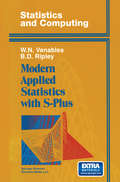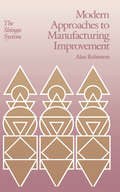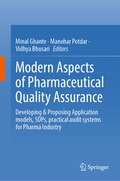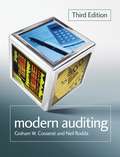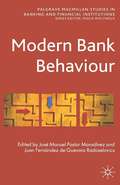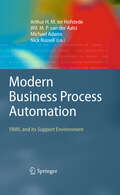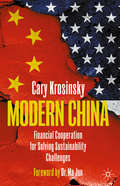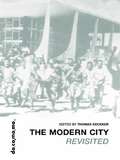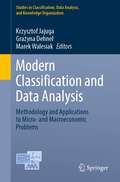- Table View
- List View
Modern Applied Statistics with S-PLUS (Statistics and Computing)
by William N. Venables Brian D. RipleyA guide to using the power of S-PLUS to perform statistical analyses, providing both an introduction to the program and a course in modern statistical methods. Readers are assumed to have a basic grounding in statistics, thus the book is intended for would-be users, as well as students and researchers using statistics. Throughout, the emphasis is on presenting practical problems and full analyses of real data sets, with many of the methods discussed being modern approaches to topics such as linear and non-linear regression models, robust and smooth regression methods, survival analysis, multivariate analysis, tree-based methods, time series, spatial statistics, and classification. This second edition is intended for users of S-PLUS 3.3, or later, and covers both Windows and UNIX. It treats the recent developments in graphics and new statistical functionality, including bootstraping, mixed effects linear and non-linear models, factor analysis, and regression with autocorrelated errors. The authors have written several software libraries which enhance S-PLUS, and these, plus all the datasets used, are available on the Internet.
Modern Applied Statistics with S-Plus (Statistics and Computing)
by W.N. Venables B.D. RipleyA guide to using S-Plus to perform statistical analyses, serving as both an introduction to the use of S-Plus and as a course in modern statistical methods. The experienced authors show how to use S-Plus as a powerful and graphical system, with the emphasis on presenting practical problems and full analyses of real data sets throughout. A basic grounding in statistics is assumed, making this book suitable for would-be users of S-Plus, as well as students and researchers using statistics.
A Modern Approach to Graham and Dodd Investing (Wiley Finance #253)
by Thomas P. AuAn updated approach to classic security analysis The principles of value investing outlined by Graham and Dodd in the 1940s continues to be used today by individuals and companies who face challenging investment decisions. A Modern Approach to Graham and Dodd Investing examines the classic Graham and Dodd approach to valuation and updates it for the twenty-first century. Thomas Au, a credentialed analyst with a leading insurance company and an ex-Value Line analyst, reworks the basics of value investing from net present value, financial statement analysis, and return on capital to return and leverage, asset allocation, and diversification. Through case studies and real-time analysis, A Modern Approach to Graham and Dodd Investing presents readers with examples that will make analysis and portfolio theory more relevant and powerful. Thomas P. Au (Hartford, CT) is a Vice President and Portfolio Manager for the investment arm of a large insurance and healthcare provider. His specialty is emerging and international markets. He received his BA, cum laude, with a double major in economics and history, from Yale University, and an MBA in finance from New York University.
A Modern Approach to Regression with R (Springer Texts in Statistics #Vol. 58)
by Simon SheatherThis book focuses on tools and techniques for building regression models using real-world data and assessing their validity. A key theme throughout the book is that it makes sense to base inferences or conclusions only on valid models. Plots are shown to be an important tool for both building regression models and assessing their validity. We shall see that deciding what to plot and how each plot should be interpreted will be a major challenge. In order to overcome this challenge we shall need to understand the mathematical properties of the fitted regression models and associated diagnostic procedures. As such this will be an area of focus throughout the book. In particular, we shall carefully study the properties of resi- als in order to understand when patterns in residual plots provide direct information about model misspecification and when they do not. The regression output and plots that appear throughout the book have been gen- ated using R. The output from R that appears in this book has been edited in minor ways. On the book web site you will find the R code used in each example in the text.
Modern Approaches to Agent-based Complex Automated Negotiation (Studies in Computational Intelligence #674)
by Katsuhide Fujita Quan Bai Takayuki Ito Minjie Zhang Fenghui Ren Reyhan Aydoğan Rafik HadfiThis book addresses several important aspects of complex automated negotiations and introduces a number of modern approaches for facilitating agents to conduct complex negotiations. It demonstrates that autonomous negotiation is one of the most important areas in the field of autonomous agents and multi-agent systems. Further, it presents complex automated negotiation scenarios that involve negotiation encounters that may have, for instance, a large number of agents, a large number of issues with strong interdependencies and/or real-time constraints.
Modern Approaches to Manufacturing Improvement: The Shingo System
by Alan RobinsonHere's the quickest and most inexpensive way to learn about the pioneering work of Shigeo Shingo, co-creator (with Taiichi Ohno) of just-in-time. It's an introductory book containing excerpts of five of his classic books as well as an excellent introduction by Professor Robinson.
Modern Approaches to Manufacturing Improvement: The Shingo System
by Alan RobinsonHere's the quickest and most inexpensive way to learn about the pioneering work of Shigeo Shingo, co-creator (with Taiichi Ohno) of just-in-time. It's an introductory book containing excerpts of five of his classic books as well as an excellent introduction by Professor Robinson.
Modern Aspects of Pharmaceutical Quality Assurance: Developing & Proposing Application models, SOPs, practical audit systems for Pharma Industry
by Minal Ghante Manohar Potdar Vidhya BhusariThe pharmaceutical quality system ensures that the process performance is suitably achieved, the product quality is regularly met, improved opportunities are identified and evaluated, and the knowledge is constantly expanded. Auditing also plays a crucial role within the pharmaceutical industry. It helps to assess and review quality to improve and build a better system for the benefit of companies. This book aims to develop a tool that will substantially decrease the number of Inspectional Observations and Warning letters, thus eliminating Import Alerts and Consent Decree. This book targets the Pharmaceutical Industry and students of Pharmaceutical Quality Assurance so they can get in hand-ready consolidated information on Pharmaceutical Quality guidelines, Quality metrics, and implementation of simplified SOP guidelines, plant layouts to implement Quality metrics for Pharmaceutical Manufacturing systems in tablets, capsules, liquid orals, and semi-solid dosage forms. The chapters cover the various aspects of Pharmaceutical Quality Assurance. The selection of topics is mainly based on the requirements of Pharmaceutical regulatory guidelines of India, the UK, the USA, Australia, and South Africa. Each chapter includes the abstract, detailed explanation, implementation guidelines, flowcharts, layouts, and Standard Operating Procedure of quality metrics for the Pharmaceutical Manufacturing System
Modern Asset Allocation for Wealth Management (Wiley Finance)
by David M. BernsAn authoritative resource for the wealth management industry that bridges the gap between modern perspectives on asset allocation and practical implementation An advanced yet practical dive into the world of asset allocation, Modern Asset Allocation for Wealth Management provides the knowledge financial advisors and their robo-advisor counterparts need to reclaim ownership of the asset allocation component of their fiduciary responsibility. Wealth management practitioners are commonly taught the traditional mean-variance approach in CFA and similar curricula, a method with increasingly limited applicability given the evolution of investment products and our understanding of real-world client preferences. Additionally, financial advisors and researchers typically receive little to no training on how to implement a robust asset allocation framework, a conceptually simple yet practically very challenging task. This timely book offers professional wealth managers and researchers an up-to-date and implementable toolset for managing client portfolios. The information presented in this book far exceeds the basic models and heuristics most commonly used today, presenting advances in asset allocation that have been isolated to academic and institutional portfolio management settings until now, while simultaneously providing a clear framework that advisors can immediately deploy. This rigorous manuscript covers all aspects of creating client portfolios: setting client risk preferences, deciding which assets to include in the portfolio mix, forecasting future asset performance, and running an optimization to set a final allocation. An important resource for all wealth management fiduciaries, this book enables readers to: Implement a rigorous yet streamlined asset allocation framework that they can stand behind with conviction Deploy both neo-classical and behavioral elements of client preferences to more accurately establish a client risk profile Incorporate client financial goals into the asset allocation process systematically and precisely with a simple balance sheet model Create a systematic framework for justifying which assets should be included in client portfolios Build capital market assumptions from historical data via a statistically sound and intuitive process Run optimization methods that respect complex client preferences and real-world asset characteristics Modern Asset Allocation for Wealth Management is ideal for practicing financial advisors and researchers in both traditional and robo-advisor settings, as well as advanced undergraduate and graduate courses on asset allocation.
Modern Asset Allocation for Wealth Management (Wiley Finance)
by David M. BernsAn authoritative resource for the wealth management industry that bridges the gap between modern perspectives on asset allocation and practical implementation An advanced yet practical dive into the world of asset allocation, Modern Asset Allocation for Wealth Management provides the knowledge financial advisors and their robo-advisor counterparts need to reclaim ownership of the asset allocation component of their fiduciary responsibility. Wealth management practitioners are commonly taught the traditional mean-variance approach in CFA and similar curricula, a method with increasingly limited applicability given the evolution of investment products and our understanding of real-world client preferences. Additionally, financial advisors and researchers typically receive little to no training on how to implement a robust asset allocation framework, a conceptually simple yet practically very challenging task. This timely book offers professional wealth managers and researchers an up-to-date and implementable toolset for managing client portfolios. The information presented in this book far exceeds the basic models and heuristics most commonly used today, presenting advances in asset allocation that have been isolated to academic and institutional portfolio management settings until now, while simultaneously providing a clear framework that advisors can immediately deploy. This rigorous manuscript covers all aspects of creating client portfolios: setting client risk preferences, deciding which assets to include in the portfolio mix, forecasting future asset performance, and running an optimization to set a final allocation. An important resource for all wealth management fiduciaries, this book enables readers to: Implement a rigorous yet streamlined asset allocation framework that they can stand behind with conviction Deploy both neo-classical and behavioral elements of client preferences to more accurately establish a client risk profile Incorporate client financial goals into the asset allocation process systematically and precisely with a simple balance sheet model Create a systematic framework for justifying which assets should be included in client portfolios Build capital market assumptions from historical data via a statistically sound and intuitive process Run optimization methods that respect complex client preferences and real-world asset characteristics Modern Asset Allocation for Wealth Management is ideal for practicing financial advisors and researchers in both traditional and robo-advisor settings, as well as advanced undergraduate and graduate courses on asset allocation.
Modern Auditing
by Graham Cosserat Neil RoddaModern Auditing has become established as one of the leading textbooks for students taking university and professional courses in auditing. This extensively revised third edition continues to provide the reader with a comprehensive and integrated coverage of the latest developments in the environment and methodology of auditing. Aimed at introductory level courses in auditing at undergraduate, graduate and professional levels, it develops the auditing process in a logical and sequential manner enabling the reader to progressively consolidate their understanding of the concepts and process. The book contains a strong pedagogical framework including: chapter overviews, learning objectives and checks, review questions, professional application questions, case studies and a glossary of technical terms. New features include: * Updated coverage of developments in companies legislation, regulation and corporate governance * Discussion of new developments in ethical codes * Coverage of the latest audit risk standards and the impact of the IAASB's Clarity Project * Focus on changes in professional statements and structure and the increasing influence of IFAC
Modern Bank Behaviour (Palgrave Macmillan Studies in Banking and Financial Institutions)
by José Manuel Pastor Monsálvez and Juan Fernández de Guevara RadoselovicsUpdated insight into key facts impacting on financial institutions after the financial crisis, highlighting areas of major policy and academic interest. The book includes ten chapters analysing contrasting issues such as intellectual capital, cost efficiency, bank stability, credit risk and business models for the wealth management industry.
Modern Banking (The Wiley Finance Series)
by Shelagh HeffernanModern Banking focuses on the theory and practice of banking, and its prospects in the new millennium. The book is written for courses in banking and finance at Masters/MBA level, or undergraduate degrees specialising in this area. Bank practitioners wishing to deepen and broaden their understanding of banking issues may also be attracted to this book. While they often have exceptional and detailed knowledge of the areas they have worked in, busy bankers may be all too unaware of the key broader issues. Consider the fundamental questions: What is unique about a bank? and What differentiates it from other financial institutions? Answering these questions begins to show how banks should evolve and adapt - or fail. If bankers know the underlying reasons for why profitable banks exist, it will help them to devise strategies for sustained growth. Modern Banking concludes with a set of case studies that give practical insight into the key issues covered in the book: The core banking functions Different types of banks and diversification of bank activities Risk management: issues and techniques Global regulation: Basel 1 and Basel 2. Bank regulation in the UK, US, EU, and Japan Banking in emerging markets Bank failure and financial crises Competitive issues, from cost efficiency to mergers and acquisitions Case Studies including: Goldman Sachs, Bankers Trust/Deutsche Bank, Sumitomo Mitsui, Bancomer
The Modern Business Data Analyst: A Case Study Introduction into Business Data Analytics with CRISP-DM and R
by Dominik JungThis book illustrates and explains the key concepts of business data analytics from scratch, tackling the day-to-day challenges of a business data analyst. It provides you with all the professional tools you need to predict online shop sales, to conduct A/B tests on marketing campaigns, to generate automated reports with PowerPoint, to extract datasets from Wikipedia, and to create interactive analytics Web apps. Alongside these practical projects, this book provides hands-on coding exercises, case studies, the essential programming tools and the CRISP-DM framework which you'll need to kickstart your career in business data analytics. The different chapters prioritize practical understanding over mathematical theory, using realistic business data and challenges of the Junglivet Whisky Company to intuitively grasp key concepts and ideas. Designed for beginners and intermediates, this book guides you from business data analytics fundamentals to advanced techniques, covering a large number of different techniques and best-practices which you can immediately exploit in your daily work. The book does not assume that you have an academic degree or any experience with business data analytics or data science. All you need is an open mind, willingness to puzzle and think mathematically, and the willingness to write some R code. This book is your all-in-one resource to become proficient in business data analytics with R, equipped with practical skills for the real world.
Modern Business Management: Creating a Built-to-Change Organization
by Doug Dockery Laureen KnudsenTransform your entire organization, not just a part of it. Take a modern look now that the world is focusing on business agility rather than thinking about team-level or even scaled Agile. Many people and businesses believe that “doing Agile” will solve all their business and organizational problems. The truth is that “doing Agile”, especially team-level agility, is not the same as being an agile organization. Authors Doug Dockery and Laureen Knudsen share their years of experience in transforming corporations and organizations to successfully compete and win in today’s fast-paced markets. Using proven techniques and stories of actual experiences in a multitude of organizations, Doug and Laureen relate what it takes to successfully transform your organization, as well as how to tell if your transformation is working. Modern Business Management details what you need to know to transform your business to deliver value and thrive. Coverage includes: What Agile means to an executive and the benefits you should be seeingThe top failure modes and why so many transformations failA framework for success, including an operational framework and a transformation frameworkHow big data internal to a company is needed to successfully run a world-wide corporation todayThe definition of a modern business and what it looks like What You’ll learn Understand why businesses are not getting the benefits out of their current Agile transformationFollow the process that organizations need to go through to succeedSee how C-level executives can benefit from Agile practicesKnow how to succeed where others are failingDiscover how to keep up with a constantly disrupted and ever-changing market Who This Book Is For Management and executives in corporations from the director level to the C-level
Modern Business Process Automation: YAWL and its Support Environment
The ?eld of Business Process Management (BPM) is marred by a seemingly e- less sequence of (proposed) industry standards. Contrary to other ?elds (e.g., civil or electronic engineering), these standards are not the result of a widely supported consolidationofwell-understoodandwell-establishedconceptsandpractices.Inthe BPM domain, it is frequently the case that BPM vendors opportunistically become involved in the creation of proposed standards to exert or maintain their in?uence and interests in the ?eld. Despite the initial fervor associated with such standardi- tion activities, it is no less frequent that vendors either choose to drop their support for standards that they earlier championed on an opportunistic basis or elect only to partially support them in their commercial offerings. Moreover, the results of the standardization processes themselves are a concern. BPM standards tend to deal with complex concepts, yet they are never properly de?ned and all-too-often not informed by established research. The result is a plethoraof languagesand tools, with no consensuson conceptsand their implem- tation. They also fail to provide clear direction in the way in which BPM standards should evolve. One can also observe a dichotomy between the “business” side of BPM and its “technical” side. While it is clear that the application of BPM will fail if not placed in a proper business context, it is equally clear that its application will go nowhere if it remains merely a motivational exercise with schemas of business processes hanging on the wall gathering dust.
Modern Capitalism: Privatization, Employee Ownership, and Industrial Democracy (Non-ser.)
by Nicholas V. GianarisThe privatization revolution, profit or revenue sharing, and employee participation in enterprise decision making are some of the major characteristics of modern capitalism. Such features can be observed in almost all countries, including Western developed, Third World, and primarily ex-socialist countries. The diffusion of stock ownership, the promotion of economic and industrial democracy, and the globalization of production and finance present new challenges and opportunities and reflect important structural economic and political changes. This book examines all these issues and provides valuable information and suggestions for labor-management relations and international business cooperation.
Modern China: Financial Cooperation for Solving Sustainability Challenges
by Cary KrosinskyCalling for more cooperation between China and the west, this new book by noted author and educator Cary Krosinsky provides readers with an on-the-ground perspective of what’s really happening in China today on the back of its recent economic rise, its desire and need to solve environmental challenges and the new positive dynamic created by its need for foreign capital. In doing so, Krosinsky and his colleagues from the Sustainable Finance Institute and Brown University highlight how China has recaptured its role as a leader in innovation, arguing that current approaches to the relationship hinder global progress on issues such as climate change, inequality, air pollution, food integrity and water security and pushes back on confrontational approaches and attempts to clarify misperceptions about contemporary China. China’s recent rise includes becoming a global leader on green policy and green finance, as it is increasingly leading the way towards modernization through innovation strategies focused on infrastructure, education, healthcare and aspects of clean energy technology, leading to opportunities across private equity, venture capital and green bonds. This creates an exciting opportunity for positive change, with environmental challenges becoming more salient to its own population, adding pressure on the government to provide solutions. China changes faster than any country in the world, creating an opportunity for meaningful, ongoing, positive transitions. Modern China is a call for more cooperation, and makes a clear, cogent case for collaboration in the face of current confrontational approaches. At the same time, dire environmental and social circumstances require an all-hands-on-deck approach. This book provides specific examples of what’s working and what’s needed to compete and thrive in this new paradigm through trusted relationships placed front and center for the future of economies and the betterment of global society.
Modern China: A Very Short Introduction (Very Short Introductions Ser.)
by Rana MitterChina today is never out of the news: from international finance to human rights controversies, global coverage of its rising international presence, and the Chinese 'economic miracle'. It seems to be a country of contradictions: a peasant society with some of the world's most futuristic cities, heir to an ancient civilization that is still trying to find a modern identity. This Very Short Introduction offers the reader an entry to understanding the world's most populous nation, giving an integrated picture of modern Chinese society, culture, economy, politics, and art. In this new edition, Rana Mitter addresses China's current global position, accounting for the country's growth in global significance over the past decade. ABOUT THE SERIES: The Very Short Introductions series from Oxford University Press contains hundreds of titles in almost every subject area. These pocket-sized books are the perfect way to get ahead in a new subject quickly. Our expert authors combine facts, analysis, perspective, new ideas, and enthusiasm to make interesting and challenging topics highly readable.
Modern City Revisited
by Thomas DeckkerThe supposed rationality of the urban planning of the Modern Movement encompassed a variety of attitudes towards history, technology and culture, from the vision of Berlin as an American metropolis, through the dispute between the urbanists and disurbanists in the Soviet Union to the technocratic and austere vision of Le Corbusier. After the Second World War, architects attempted to reconcile these utopian visions to the practical problems of constructing - or reconstructing - urban environments, from Piero Bottoni at the Quartiere Trienale 8 in Milan in 1951 to Lucio Costa at Bras'lia in 1957. In the 1970s, the collapse of Modernism brought about universial condemnation of Modern urbanism; urban planning,and rationality itself, were thrown into doubt. However, such a wholesale condemnation hides the complex realities underlying these Modern cities. The contributors define some of the theoretical foundations of Modern urban planning, and reassess the successes and the failures of the built results. The book ends with contrasting views of the inheritance of Modern urbanism in the United States and the Netherlands.
Modern City Revisited
by Thomas DeckkerThe supposed rationality of the urban planning of the Modern Movement encompassed a variety of attitudes towards history, technology and culture, from the vision of Berlin as an American metropolis, through the dispute between the urbanists and disurbanists in the Soviet Union to the technocratic and austere vision of Le Corbusier. After the Second World War, architects attempted to reconcile these utopian visions to the practical problems of constructing - or reconstructing - urban environments, from Piero Bottoni at the Quartiere Trienale 8 in Milan in 1951 to Lucio Costa at Bras'lia in 1957. In the 1970s, the collapse of Modernism brought about universial condemnation of Modern urbanism; urban planning,and rationality itself, were thrown into doubt. However, such a wholesale condemnation hides the complex realities underlying these Modern cities. The contributors define some of the theoretical foundations of Modern urban planning, and reassess the successes and the failures of the built results. The book ends with contrasting views of the inheritance of Modern urbanism in the United States and the Netherlands.
Modern Classical Economics and Reality: A Spectral Analysis of the Theory of Value and Distribution (Evolutionary Economics and Social Complexity Science #2)
by Theodore Mariolis Lefteris TsoulfidisThis book presents an in-depth, novel, and mathematically rigorous treatment of the modern classical theory of value based on the spectral analysis of the price–profit–wage rate system. The classical theory is also subjected to empirical testing to show its logical consistency and explanatory content with respect to observed phenomena and key economic policy issues related to various multiplier processes. In this context, there is an examination of the trajectories of relative prices when the distributive variables change, both theoretically and empirically, using actual input–output data from a number of quite diverse economies. It is suggested that the actual economies do not behave like the parable of a one-commodity world of the traditional neoclassical theory, which theorizes the relative scarcities of “goods and production factors” as the fundamental determinants of relative prices and their movement. By contrast, the results of the empirical analysis are fully consistent with the modern classical theory, which makes the intersectoral structure of production and the way in which net output is distributed amongst its claimants the fundamental determinants of price magnitudes. At the same time, however, these results indicate that only a few vertically integrated industries (“industry core” or “hyper-basic industries”) are enough to shape the behaviour of the entire economy in the case of a disturbance. This fact is reduced to the skew distribution of the eigenvalues of the matrices of vertically integrated technical coefficients and reveals that, across countries and over time, the effective dimensions of actual economies are surprisingly low. Normal 0 false false false EN-US JA X-NONE />
Modern Classics in Entrepreneurship Studies: Building the Future of the Field
by Banu Ozkazanc-Pan Arturo E. Osorio Dev K. Dutta Vishal K. Gupta Golshan Javadian Grace Chun GuoThe purpose of this book is to identify and analyze modern classics in entrepreneurship research with the goal of highlighting cutting-edge themes in the work of various scholars that are pushing the boundaries of the field, post 2000. As the entrepreneurship field matures, it is important to identify the novel contributions that will help shape the next decades of scholarship, by providing scholars with the concepts, frameworks, and approaches needed to help develop the new theories and practices of entrepreneurship. By focusing on emerging key contributions, this book takes a stance that sets it apart from other similar works by scholars that have focused only on existing themes rather than those that will characterize the relationship between entrepreneurship and new technological advances, growing inequalities, gender, diversity and inclusion, and socio-political shifts in the landscape of entrepreneurial ecosystems, allowing for critical and new conversations on entrepreneurship to take shape. This book will provide discussion on emergent themes and approaches that will continue to build the future of entrepreneurship as an exciting and rigorous academic discipline.
Modern Classification and Data Analysis: Methodology and Applications to Micro- and Macroeconomic Problems (Studies in Classification, Data Analysis, and Knowledge Organization)
by Krzysztof Jajuga Marek Walesiak Grażyna DehnelThis volume presents a selection of peer-reviewed papers that address the latest developments in the methodology and applications of data analysis and classification tools to micro- and macroeconomic problems. The contributions were originally presented at the 30th Conference of the Section on Classification and Data Analysis of the Polish Statistical Association, SKAD 2021, held online in Poznań, Poland, September 8–10, 2021. Providing a balance between methodological and empirical studies, and covering a wide range of topics, the book is divided into five parts focusing on methods and applications in finance, economics, social issues and to COVID-19 data. The book is aimed at a wide audience, including researchers at universities and research institutions, PhD students, as well as practitioners, data scientists and employees in public statistical institutions.
The Modern/Colonial/Capitalist World-System in the Twentieth Century: Global Processes, Antisystemic Movements, and the Geopolitics of Knowledge (Studies in the Political Economy of the World-System)
An important building block for further advancing world-system theory, this book considers the theory from the perspectives of global processes and antisystemic movements, feminist theory, and the aftermath of the colonial system. The volume addresses three myths tied to Eurocentric forms of thinking: objectivist and universalist knowledges, the decolonization of the modern world, and developmentalism. All three myths, the authors argue, conceal the continued hierarchical and unequal relations of domination and exploitation between European and Euro-American centers and non-European peripheral regions. In this volume, world-system scholars address these and related aspects of the modern/colonial capitalist world-system.Addressing the myth of universalist knowledge, the volume reminds us that our knowledge is situated in the gender, class, racial, and sexual hierarchies of a specific region in the world-system, while the coloniality of power additionally situates our knowledge. The volume further argues that the postcolonial era retains the hierarchy of colonialism, and the possibility of national development without global structural changes is one of the greatest 20th-century myths. Taking these perspectives into consideration, the contributors examine and help to refine classic world-system theory.

